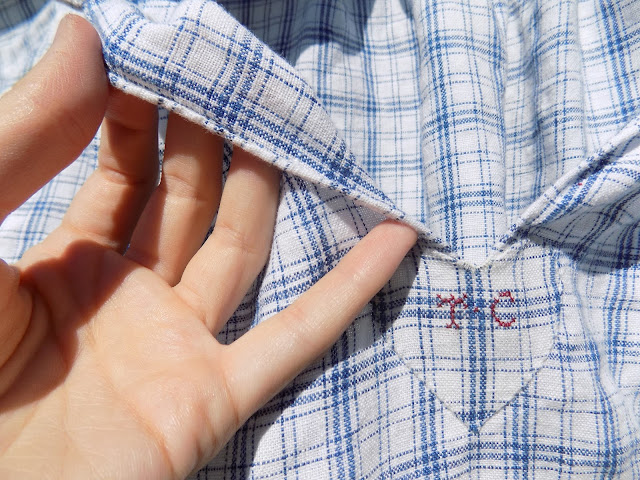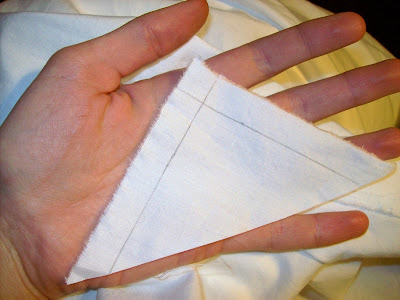18th century Garsault shirt
Last month, I wrote about researching an upcoming shirt project. Well, I made the shirt a few weeks ago, and I am so happy with it! I used Garsault's instructions from L'art du tailleur, which La Couturiere Parisienne graciously shared on http://www.marquise.de/en/1700/howto/maenner/18hemd.shtml. I followed these instructions pretty closely since I am not yet familiar enough to sew on the fly, but I would really like to study several original shirts. La Couturiere Parisienne made the instructions very easy to follow, but there is a feature of Garsault's approach that I and my customer both disliked. The neck gusset is set into the shoulder strap instead of the shoulder strap. I'll illustrate with pictures below. It's fine for now, but next time I'll do it differently.
 |
| Narrow rolled hem edge on the neck slit, plus the reinforcement heart as per Garsault's version |
The neckline is stroke gathered to the collar, while the neck gusset and shoulder strap are sewn flat to the collar--no gathers. Next time, I need to make the front of the neck gather more loosely to measure longer between the front edge of the collar and where the shoulder strap meets the collar. I would have to gather the back of the neck tighter so as not to make the neck circumference longer. The reason for this approach is because on this shirt, the shoulder straps sit forward on the shoulders. I did not account for the overlap where the collar buttons, and I think it's also because the expanse of the chest is different from the expanse of the shoulders. I joked that I made this shirt to fit a rectangular prism, not a human :) Next time, I'll pin the collar where I want it before I sew it. I'll have someone model it so that I can make the straps sit on top of the shoulders instead of slightly forward.
 | ||
Here are some close-up photos of the cuffs. I stroke gathered the voluminous sleeves to the narrow cuffs. Then, I used back stitches to top stitch the cuffs along both edges, which gives a very professional appearance while also reinforcing the cuffs. I wasn't sure if this was standard procedure; I just did it because I thought I had seen it on other shirts. I did some post-completion research for future reference. I looked at pictures of shirts listed on http://www.larsdatter.com/18c/shirts.html. Most of these shirts are later 18th century and have wide cuffs that don't appear to have top stitching. Here's one with a close up of a cuff: A New England Shirt, found in the Perry-Thrasher House, in Rehoboth, Massachusetts; made of white cotton muslin, possibly a boy’s size http://www.18cnewenglandlife.org/Cuff.htm. No top stitching on this one. If any of my readers know about cuff top stitching (or anything else, for that matter!), please comment.
My thread buttons are terrible, by the way. These are the first I've ever made. I used a doubled length of 60/2 linen sewing thread--the same thread that I used to sew the shirt--and wrapped it around a knitting needle to make a ring, then sewed blanket stitches all around the thread ring. I read about how to make them, but I can't remember where I encountered those instructions. Next time, I'll use thicker thread. The sewing thread took forever.
I'm not too happy with my buttonholes. I used some silk buttonhole thread from my grandmother, but it was really loosely twisted. I need to get some better thread.
 |
| This is the gusset at the bottom of the side seam. |
Here you can see the shoulder straps. I've seen much narrower ones on other people's shirts, so I was surprised at how wide Garsault made them. See how the gusset is set into the strap as well as into the neckline of the shirt? That seems unusual. Next time, I'll set the gusset into the shirt, and then apply a narrow strap on top of it. I'd like to find pictures of shoulder straps on original shirts, but museums rarely put close up images on their online archives. I attached these straps by back stitching near the edges.
Here's the interior of a side seam. All of the long seams of this shirt are machine sewn and hand felled. Honestly, it's not worth it to do some machine sewing because there is so little that can be done on a machine that won't show from the outside. I could only do the side seams, the sleeve seams, the underarm gussets, the armscye, and the front edges of the collar on a sewing machine. It's worth taking an extra couple hours to hand sew all of that.
The sleeves needed to be gathered to fit into the armscye. I gathered only a very small section at the top. I sewed most of the armscye on a sewing machine and left just a one to two inch section at the top of the shoulder, which I stroke gathered to the top of the armscye. I felled everything on the armscye except the stroke gathers. In the past, I've covered armscye gathers with a reinforcement piece of fabric appliqued on the interior of the shirt. Some of the originals on http://www.larsdatter.com/18c/shirts.html show very wide armscye reinforcement. That's another detail that I'd love to research on originals.
The theme of this month's Historical Sew Fortnightly is "October – Heroes – Make a garment inspired by your historical hero, or your historical costuming hero." François Alexandre Pierre de Garsault was a member of the French Academy of Sciences which influenced Enlightenment thinking. French religious and political leaders suppressed freedom of thinking, yet today we have resources to consult because the free thinkers defied authority to document educational materials. I don't know much about Garsault, but it's possible that he faced some of the backlash from authorities for his scientific pursuits. Thanks to him, I had detailed instructions for how to make this shirt.
The Challenge: Heroes
Material: 100% linen
Pattern: Garsault's instructions
Year: mid 18th century
Notions: linen sewing thread, buttons made from linen thread, silk embroidery thread
How historically accurate is it? 7/10 I guess; it has machine sewing
Hours to complete: 13
First worn: tried on for pictures
Total cost: about $30 U.S. for fabric



















Comments
Post a Comment